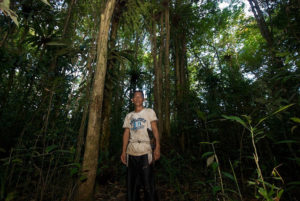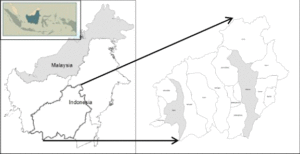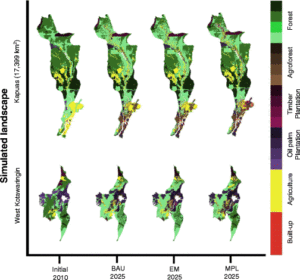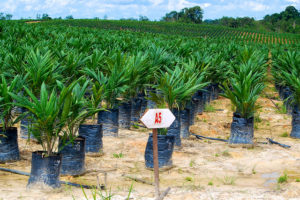
By Kerstin Reisdorf
For six years, Indonesia has used a moratorium on cutting down primary forests as a means to reduce deforestation and the carbon (CO2) emissions associated with forest loss. Although the concrete benefits of the moratorium are questionable, researchers and policy-makers still see a forest moratorium as an important instrument to mitigate climate change and protect biodiversity. It is hard to imagine how Indonesia will meet its Intended Nationally Determined Contributions (INDC) to reduce greenhouse gas emissions (GHG) by 29 percent by 2030 compared with the business as usual scenario without a forest conversion moratorium, says Meine van Noordwijk, Chief Science Adviser of the World Agroforestry Centre (ICRAF) and Coordinator of the landscapes theme of the CGIAR Research Program on Forests, Trees and Agroforestry (FTA). A new study under FTA shows a way of how a forest moratorium could be designed to be more effective.
“We modelled land-use change and ecosystem services, namely CO2 storage, in two Indonesian districts,” van Noordwijk explains. “Our aim was to find out how forest moratorium policies influence companies and communities in their decisions about how to use the land.”
The location
This study was conducted for West Kotawaringin and Kapuas districts in Central Kalimantan Province which are very different.

West Kotawaringin is situated in the western part of Central Kalimantan with a total area of about 8381 km2. The district has a population density of about 28 people per square kilometer and an annual population growth rate of 4.2 %. Timber from natural forest and forest plantations has been the main livelihood of the local population for more than two decades. The boom in the timber industry benefited people and district government alike: West Kotawaringin became one of the richest districts in Central Kalimantan.
“But then their fortune took a change for the worse,” van Noordwijk says. The logging and timber industry collapsed in the mid 2000s and palm oil prices went up sharply worldwide. “Logging companies shifted their business to oil palm. Even the locals started to convert their forest and agroforest areas to oil palm, sometimes illegally,” he adds.
Kapuas district is located in the south east of Central Kalimantan with a total area of 17,339 km2. In the mid-nineties, most of the peat forest was converted to agriculture for a mega rice project. Many people from the islands of Java, Sumatra and Bali were relocated to Kapuas to work there.
But the project failed after only five years, leaving in its wake degraded peat forest and poverty. Many of the migrant workers left the area so that the population density fell to around 19 people per km2, the population growth rate stands at 0.7 %. Now timber production and non-timber forest products (NTFP) make for the main livelihoods.

The modelling
Van Noordwijk and his colleagues wanted to find out what it takes to influence companies and individuals in a way that they conserve the forest and thus reduce carbon emissions.
They looked at seven products and ecosystem services:
- rattan (Calamus),
- jelutong (Dyera costulata),
- timber (various species),
- rubber (Hevea brasiliensis),
- oil palm (Elaeis guineensis),
- paddy (Oryza sativa) and
- carbon stocks.
“The carbon stocks were of course what we were most interested in to show the potential of a forest moratorium to help Indonesia meet its commitment to mitigate climate change,” van Noordwijk says.
The agent-based model they used is called Land-Use Change and Ecosystem Services (LUCES) and requires inputs of various maps and parameter values such as market prices, returns on land and labour, production, employment, demographics and ecosystem service supply.
Both households and companies of course make land-use decisions based on market prices, but local people are also influenced by their perception of how to improve their income and reap other benefits.

In the forest moratorium scenario, we simulated the recent implementation of the forest conversion moratorium and two alternatives as follows
- Business as usual reflects the current trend, including the forest conversion moratorium, which initially ran from 2011 to 2014. The moratorium applies only to new or extended permits for companies converting peat forest to other land use; it does not apply to local communities.
- The extended moratorium scenario extends the period of the forest conversion moratorium to 25 years starting from 2011. The forest conversion moratorium applies to new or extended permits for companies converting peat forest to other land use; it does not apply to local communities.
- The moratorium plus livelihoods scenario adds an improved livelihood program to the moratorium with enhanced markets for non-timber forest products (NTFPs), agroforestry products and community timber, e.g. an increase of farm-gate prices by 15 percent.
The results
“We were pleased to see that that this last combination of moratorium plus, if you want to call it that, significantly slows down land-use change,” van Noordwijk says. Compared to business as usual, this scenario could slow down conversion of forest on mineral soil and peat forest by about six and five percent, respectively.
In West Kotawaringin, a moratorium plus livelihood benefits scenario could expand forest and agroforest areas and subsequently the supply of timber, rattan, jelutong, rubber; and it would increase CO2 storage. The increase in total carbon sequestration could reduce CO2 emissions by about 23 percent. For the Kapuas district the potential reduction of CO2 emissions under the same scenario was 15 percent.
According to the researchers, these results confirm previous studies which had found that premium prices for NTFP, agroforestry rubber and community timber could change local perceptions of forest and agroforest conservation and therefore reduce potential CO2 emissions from land-use change.
It is noteworthy that for the wealthier district West Kotawaringin the extension of the forest moratorium made hardly a difference because both households and companies can expect high incomes from oil palm. Extending the period of the moratorium only stops private companies from converting peat forests to oil palm but not households, since this regulation only applies to companies.
For households, however, premium prices for NTFPs, agroforestry rubber and community timber, can have an effect on their expectations and land-use decisions, both in the wealthier and poorer district.
The good news
The study means good news for a government that has committed itself to ambitious climate goals but cannot disregards its needs for economic development to overcome poverty, the researchers are convinced of that. According to the World Bank, 28.6 million Indonesians still live below the poverty line and around 40 percent remain clustered around the national poverty line of 330,776 rupiah per person per month ($22.60).
A policy that combines a forest moratorium with livelihood support and increases farm-gate prices of forest and agroforestry products could increase local communities’ benefits from conservation. Forest and agroforestry areas that are profitable and competitive are more likely to be conserved. This means that potential carbon emissions could be reduced by about 36 percent.
“We think that the LUCES model could be a useful tool to help the Indonesian government fine-tune its policies so that it can achieve its INDCs. It has been stated that with international support, Indonesia could cut down its GHG emission by 41 percent by 2030. An effective moratorium would boost Indonesia’s credibility vis-à-vis international donors such as Norway who have shown their support for helping the country transition to a climate-friendly, sustainable development path,” van Noordwijk says.
Read the study











